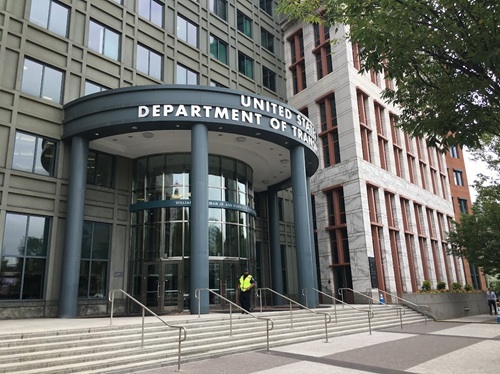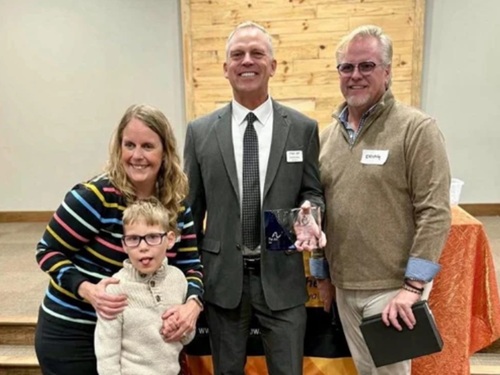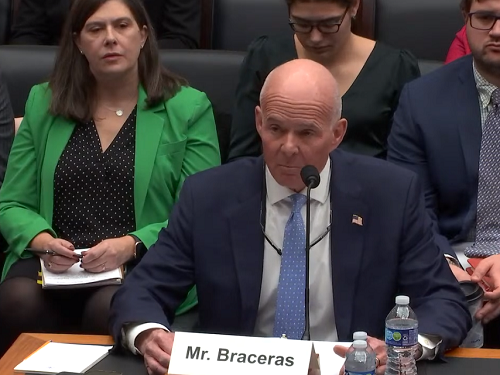The House of Representatives Committee on Transportation and Infrastructure held a hearing on February 15 to elicit the perspectives of transportation stakeholders on the implementation of new “Buy America” provisions
[Above photo via the House T&I committee]
Carlos Braceras – executive director of the Utah Department of Transportation – testified on behalf of the American Association of State Highway and Transportation Officials at the hearing.

The other witnesses appearing at this hearing were: Ty Edmondson, CEO of the T. A. Loving Company on behalf of the Associated General Contractors of America; Dan Needham, executive vice president-commercial for Nucor Corporation; Brian Enders, vice president of Walbec Group on behalf of the National Asphalt Pavement Association; and Megan Salrin, legislative representative for the United Steelworkers union.
“As you know, a key policy priority included in the IIJA [Infrastructure Investment and Jobs Act] pertains to new ‘Build America, Buy America’ requirements,” Braceras – who is also a former president of AASHTO – noted in his testimony.
“AASHTO and the state DOTs remain unwavering in our strong support of the goal to increase America’s manufacturing capacity by creating new domestic jobs and encouraging economic growth; however, we also recognize this transformation can’t occur overnight or with the flip of a switch,” he said. “As such, we firmly believe that a deliberative and practitioner-informed process between government and industry should continue to guide implementation of ‘Buy America’ rules. This will ensure timely, cost-effective investments and successful delivery of critical transportation infrastructure projects funded through the IIJA.”

He noted that, for more than 40 years, “Buy America” statutes have required a domestic manufacturing process for iron, steel and certain manufactured products permanently incorporated into federal-aid highway and transit projects.
The IIJA, however, expanded “Buy America” coverage to five categories of construction materials – non-ferrous metals, plastic and polymer-based products, glass, lumber, and drywall.
“With the 2024 transportation construction season on the horizon, there remains significant concern regarding the readiness of industry for the transition to recent and anticipated increases in ‘Buy America’ requirements,” Braceras stressed.
“State transportation agencies are continuing to experience material and product delivery delays due to supply chain issues, material shortages, and worker shortages,” he said. “Materials including aluminum, which is used in numerous products including light poles, mast arms, and sign panels; glass beads, which are used in retro-reflective pavement markings; fiber optic cable; epoxy; and plastic pipe/conduit have been in short supply around the country over the past two years—contributing to ongoing delivery delays for these critical items.”
While construction projects are accustomed to complex realities of utility relocation, Braceras said state DOTs are experiencing “further” delays as part of their efforts to comply with new “Buy America” rules.
“Congress intended the IIJA to spur expansion of America’s manufacturing capacity, promote the creation of jobs across the country, and encourage economic growth,” he pointed out. “To ensure timely and successful delivery of critical infrastructure projects enabled under IIJA, the White House, Office of Management and Budget (OMB), and USDOT should deploy a deliberative, practitioner- and industry-informed process for ‘Buy America’ implementation.”
Braceras added that while AASHTO understands the complex nature of implementing the new “Buy America” requirements across the entire federal government, it is important to recognize the disruption that occurs when OMB and USDOT frequently update and alter previously issued guidance.
“Every state DOT expends significant effort to change specification language, quality assurance language, and other documentation and to train state DOT employees on how to comply with any guidance,” he said.
“Consistency not only helps state DOTs but also our transportation industry partners. Therefore, it is important that any issued guidance not be a moving target,” Braceras emphasized. “As state DOTs prepare, plan, and design projects for 2024 bid lettings, it is important to ensure that the transportation industry is prepared for and fully understands the new requirements. For uncertainty related to guidance due to frequent revisions to the process on how to comply with the law can impact the ability to adequately source and procure products, can increase costs, and lead to possible project delays.”
 Top Stories
Top Stories
USDOT Issues $1B in Local Road Safety Funding
January 2, 2026 Top Stories
Top Stories

